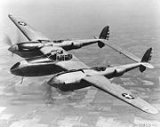
P-38 Lightning
Overview
The Lockheed P-38 Lightning was a World War II
American fighter aircraft
built by Lockheed
. Developed to a United States Army Air Corps
requirement, the P-38 had distinctive twin boom
s and a single, central nacelle
containing the cockpit and armament. Named "fork-tailed devil" by the Luftwaffe
and "two planes, one pilot" by the Japanese, the P-38 was used in a number of roles, including dive bombing
, level bombing
, ground-attack, photo reconnaissance
missions, and extensively as a long-range
escort fighter when equipped with drop tank
s under its wings.
The P-38 was used most successfully in the Pacific Theater of Operations
and the China-Burma-India Theater of Operations
as the mount of America's top ace
s, Richard Bong
(40 victories) and Thomas McGuire
(38 victories).
World War II
World War II, or the Second World War , was a global conflict lasting from 1939 to 1945, involving most of the world's nations—including all of the great powers—eventually forming two opposing military alliances: the Allies and the Axis...
American fighter aircraft
Fighter aircraft
A fighter aircraft is a military aircraft designed primarily for air-to-air combat with other aircraft, as opposed to a bomber, which is designed primarily to attack ground targets...
built by Lockheed
Lockheed Corporation
The Lockheed Corporation was an American aerospace company. Lockheed was founded in 1912 and later merged with Martin Marietta to form Lockheed Martin in 1995.-Origins:...
. Developed to a United States Army Air Corps
United States Army Air Corps
The United States Army Air Corps was a forerunner of the United States Air Force. Renamed from the Air Service on 2 July 1926, it was part of the United States Army and the predecessor of the United States Army Air Forces , established in 1941...
requirement, the P-38 had distinctive twin boom
Twin boom
Twin-boom aircraft have their tailplanes and vertical stabilizers mounted on the tail of either two fuselages or on two booms fixed to either both sides of the single fuselage, the wings or the engine nacelles.The reason for this design choice may be:...
s and a single, central nacelle
Nacelle
The nacelle is a cover housing that holds engines, fuel, or equipment on an aircraft. In some cases—for instance in the typical "Farman" type "pusher" aircraft, or the World War II-era P-38 Lightning—an aircraft's cockpit may also be housed in a nacelle, which essentially fills the...
containing the cockpit and armament. Named "fork-tailed devil" by the Luftwaffe
Luftwaffe
Luftwaffe is a generic German term for an air force. It is also the official name for two of the four historic German air forces, the Wehrmacht air arm founded in 1935 and disbanded in 1946; and the current Bundeswehr air arm founded in 1956....
and "two planes, one pilot" by the Japanese, the P-38 was used in a number of roles, including dive bombing
Dive bomber
A dive bomber is a bomber aircraft that dives directly at its targets in order to provide greater accuracy for the bomb it drops. Diving towards the target reduces the distance the bomb has to fall, which is the primary factor in determining the accuracy of the drop...
, level bombing
Level bomber
High level bombing is a tactic of dropping bombs while in high altitude. The term is used as a counterpart to both World War II dive bombing and low-level bombing. Before the age of precision guided munitions , it was mostly used for strategic bombing, in other words to damage enemy's economy and...
, ground-attack, photo reconnaissance
Reconnaissance
Reconnaissance is the military term for exploring beyond the area occupied by friendly forces to gain information about enemy forces or features of the environment....
missions, and extensively as a long-range
Range (aircraft)
The maximal total range is the distance an aircraft can fly between takeoff and landing, as limited by fuel capacity in powered aircraft, or cross-country speed and environmental conditions in unpowered aircraft....
escort fighter when equipped with drop tank
Drop tank
In aeronautics, a drop tank is used to describe auxiliary fuel tanks externally carried by aircraft. A drop tank is expendable and often jettisonable...
s under its wings.
The P-38 was used most successfully in the Pacific Theater of Operations
Pacific Theater of Operations
The Pacific Theater of Operations was the World War II area of military activity in the Pacific Ocean and the countries bordering it, a geographic scope that reflected the operational and administrative command structures of the American forces during that period...
and the China-Burma-India Theater of Operations
China Burma India Theater of World War II
China Burma India Theater was the name used by the United States Army for its forces operating in conjunction with British and Chinese Allied air and land forces in China, Burma, and India during World War II...
as the mount of America's top ace
Flying ace
A flying ace or fighter ace is a military aviator credited with shooting down several enemy aircraft during aerial combat. The actual number of aerial victories required to officially qualify as an "ace" has varied, but is usually considered to be five or more...
s, Richard Bong
Richard Bong
Richard Ira "Dick" Bong is the United States' highest-scoring air ace, having shot down at least 40 Japanese aircraft during World War II. He was a fighter pilot in the U.S. Army Air Forces and a recipient of the Medal of Honor...
(40 victories) and Thomas McGuire
Thomas McGuire
Thomas Buchanan McGuire Jr. was the second highest scoring American ace during World War II, whose memory was preserved by the naming of McGuire Air Force Base in Burlington County, New Jersey.-Early years:...
(38 victories).

